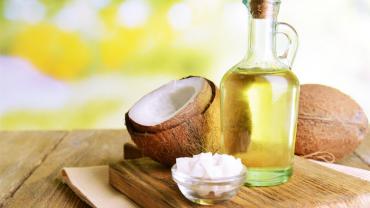
Coconut oil: it’s good for cooking great for the skin and now that word is spreading about the brain-boosting effects of ketones derived from medium-chain fatty acids people are putting heaping spoonfuls of it in their morning coffee or tea.
The exponential increase in the popularity of Paleo low-carb and ketogenic diets means that local supermarkets now carry a dizzying array of coconut oils where once there was a sea of olive canola and other oils. It has long been noted that coconut oil—or rather specifically the lauric acid in coconut oil—is antimicrobial and antiviral. (This may contribute to disease resistance among populations in the warm humid tropics of Southeast Asia.) But is this actually true? Is lauric acid worthy of its health hype?
(And on a related note is coconut oil itself worthy of the beating it took recently from the American Heart Association? Science journalist Gary Taubes likened the AHA’s publication to the Bing Crosby song – “accentuate the positive eliminate the negative” – highlighting how much contradictory evidence must be ignored in order to conclude that highly polyunsaturated vegetable oils (such as corn soybean and cottonseed) are better for health than the saturated fatty acids found in coconut oil. In Taubes’s words “it’s cherry picking and it’s how a lawyer builds an argument but not how a scientist works to establish reliable knowledge […].” Another scathing critique of the AHA paper was provided by Paleolithic diet authority Nora Gedgaudas who wrote “The AHA’s ‘new’ declaration was so nonsensical and full of errors that there is widespread speculation that all of this must be a hoax. […] The nutritionally illiterate AHA really still thinks they can sell this obsolete swill to us? This AHA declaration basically does little more than echo the long-since tired and thoroughly debunked decades-old failed policy of our USDA government guidelines. […] In fact there is also a certain degree of potential legal culpability in the AHA’s wanton ignorance blatant disregard for more current science and intentional misleading of the American people.”)
But back to lauric acid!
In an era of misinformation indeed lauric acid does have a substantial body of legitimate scientific evidence backing up claims for its efficacy against an impressive breadth of viruses and pathogenic organisms. While the ketone-elevating effects of medium-chain triglycerides seem to come predominantly from caprylic and capric acids (with 8 and 10 carbon atoms respectively) the predominant antimicrobial antiparasitic and antiviral component in coconut oil is 12 carbon lauric acid. Palm kernel oil is another good source of lauric acid and lauric acid is also present in human breast milk (as 3.5-6.6 percent of total calories) where it’s believed to be the main antiviral and antibacterial compound.
It’s not just lauric acid itself that confers benefits. The mono-ester monolaurin (glycerol monolaurate) has much greater virucidal and bactericidal activity than isolated lauric acid. Humans metabolize small amounts of monolaurin from lauric acid but the amount is believed to be relatively low and as a therapeutic intervention monolaurin is typically required in higher amounts than would be obtained from reasonable amounts of coconut oil in the diet.
Monolaurin may be especially helpful for individuals plagued by chronic recurrent stealth infections such as those linked to Lyme disease and conditions involving chronic fatigue. Some typically difficult to treat infections may result from viruses that are encapsulated in such a way that they cloak themselves in parts of the infected individual’s own cell membranes and are thus “hidden” from the immune system. In such cases monolaurin may be an effective choice.
Monolaurin is believed to inactivate lipid-coated viruses by binding to the lipid-protein viral envelope thereby preventing it from attaching to and entering host cells rendering infection and replication impossible. Evidence also suggests that monolaurin solubilizes the lipids and phospholipids in the viral envelope causing disintegration of this protective envelope and killing the virus.
Additionally as a lipid-based surfactant monolaurin is effective against microbial biofilms which are associated with a variety of clinical presentations including periodontitis otitis media endocarditis biliary tract infections prostatitis osteomyelitis burn wound infections surgical site infections and device-related infections such as those associated with catheters sutures and stents.34 Biofilm-associated bacteria are typically less susceptible to antibiotic therapy than are free-living bacteria possibly owing to the inability of some antibiotics to fully penetrate the biofilm and interact directly with bacteria. Researchers believe this is due to “the presence of occasional areas of lipid-containing matrix encasing some bacteria within the biofilm. This lipid matrix prevented comparatively small ordinarily diffusible molecules from coming into contact with the encased bacterial cells. In light of these findings it is conceivable that antibiotics may be able to diffuse through the biofilm but not come in contact with all bacterial cells throughout the biofilm. There may be areas in the biofilm that are shielded by a lipid hydrophobic barrier that prevents diffusion of antibiotics into these areas.”3 As a surfactant capable of disrupting lipid-containing structures monolaurin was shown to interfere with biofilm development by Staphylococcus aureus and Enterococcus faecalis. An additional mechanism behind monolaurin’s antimicrobial effects is that it can be inserted into bacterial cell membranes “and subtly modify membrane structure to interfere with the conformational shifts in the structure of transmembrane proteins by which signals are projected through membranes” thereby impairing bacterial intercellular communication.
The list of pathogens monolaurin has been shown to inactivate reads like a who’s who of common infections and illnesses: herpes simplex virus chlamydia trachomatis gram-positive and gram-negative bacteria yeast fungi and protozoa including candida albicans several species of ringworm and the giardia parasite.
As if all that weren’t enough unlike conventional antibiotics monolaurin has not been shown to result in antibacterial resistance nor to have adverse effects on beneficial intestinal flora. As such in addition to acute therapeutic use it may also be used as a potential preventive measure during cold and flu season or taken on an ongoing basis by those susceptible to recurrent infection and illness.